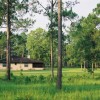 Wildfire is one of the most serious and publicized challenges facing interface forest management. Wildfires can change forest vegetation, affect human health, and cause millions of dollars’ worth of damage to homes, businesses, timber, and tourism. This 5-page fact sheet outlines tips for the firewise community development, design of structures, landscaping and fuel reduction. Written by Bruce Hull, Sarah F. Ashton, Rien M. Visser, and Martha C. Monroe, and published by the UF Department of School of Forest Resources and Conservation, August 2012.
Wildfire is one of the most serious and publicized challenges facing interface forest management. Wildfires can change forest vegetation, affect human health, and cause millions of dollars’ worth of damage to homes, businesses, timber, and tourism. This 5-page fact sheet outlines tips for the firewise community development, design of structures, landscaping and fuel reduction. Written by Bruce Hull, Sarah F. Ashton, Rien M. Visser, and Martha C. Monroe, and published by the UF Department of School of Forest Resources and Conservation, August 2012.
http://edis.ifas.ufl.edu/fr249
Tag: Wildland Fires
FOR-179/FR249 Forest Management in the Interface: Reducing Fire Risk
FOR-179, a 6-page illustrated fact sheet by Bruce Hull, Sarah F. Ashton, Rien M. Visser, and Martha C. Monroe, describes qualities of firewise communities, structures, and landscapes in proximity with fire-dependent ecosystems, and techniques for fuel reduction. Includes references. Published by the UF School of Forest Resources and Conservation, July 2008.
http://edis.ifas.ufl.edu/FR249
